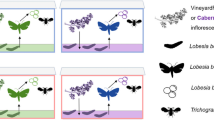Abstract
The effect of elevated CO2 on the demography of the arachnid species Tetranychus urticae feeding on Phaseolus vulgaris plants was analysed. This class of herbivores (Arachnida) and its feeding guild (cell content feeders) are under-represented in studies of the combined effects of herbivory and CO2. The growth of bean was strongly stimulated by elevated CO2. The number of leaves on lateral stems and of flowers increased but pod weight decreased. Leaf nitrogen content was 25% lower at elevated CO2 due to an increase in non-structural sugar concentration. Leaf water content was lower at elevated CO2 while leaf-specific mass and epidermis thickness were higher. Females of the mite raised at ambient or elevated CO2, but all fed with leaves grown at ambient CO2, had similar progenies. When females were raised on plants grown at elevated CO2, the numbers of their progeny were reduced by 34% and 49% in the first and second generation respectively. Later stages of development were more reduced in elevated CO2, suggesting that both fecundity and rate of development were affected. This study suggests that the abundance of T. urticae, and consequently the damage to the many crops it infests, might decrease in a future elevated-CO2 environment.
Similar content being viewed by others
Author information
Authors and Affiliations
Additional information
Received: 8 May 1999 / Accepted: 4 November 1999
Rights and permissions
About this article
Cite this article
Boutaleb Joutei, A., Roy, J., Van Impe, G. et al. Effect of elevated CO2 on the demography of a leaf-sucking mite feeding on bean. Oecologia 123, 75–81 (2000). https://doi.org/10.1007/s004420050991
Issue Date:
DOI: https://doi.org/10.1007/s004420050991




